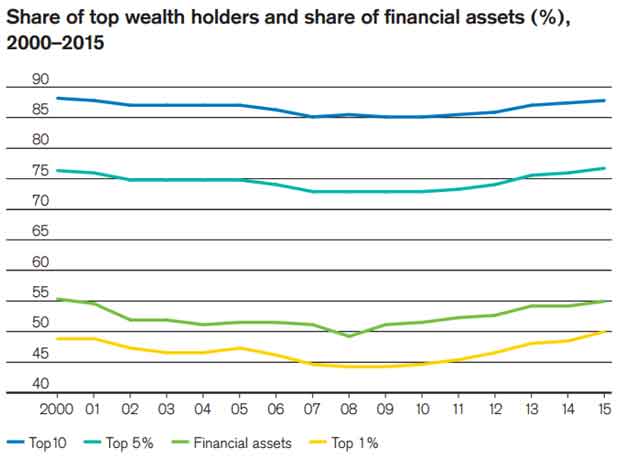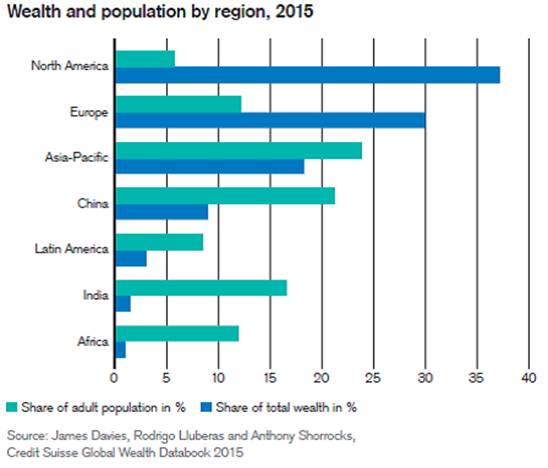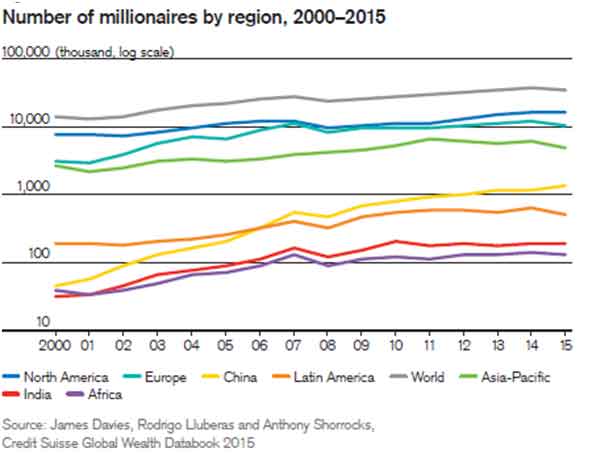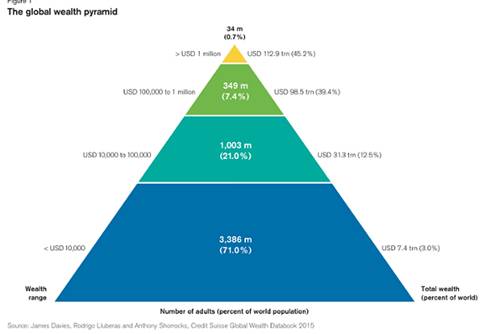Inequality: A Political Agenda
By Omar Rashid Chowdhury
18 October, 2015
Countercurrents.org
Inequality, one of the contradictions characterizing class struggle in the prvalent system, is a key structural anomaly of the system. The anomaly demands to be identified as an agenda, and that too as a political one. The agenda of inequality and increasing inequality in the present global socio-economic-politicl system is subtly shunned away by the mainstream and often ignored or missed by the stream opposing the mainstream.
Increasing inequality is coated with the safer-, softer- and easier-to-deal-withword ‘Poverty'. The mainstream serving the system prefers ‘poverty' to ‘inequality', as poverty can be defined and dealt with without major tweaking of the structural components of the system while inequality, one of the core contradictons now turned a crisis, requires significant, radical re-structuring of the system.
Facts: not stranger than fiction
Global inequality has reached a new peak, and half of the world's wealth is now owned by the richest 1% of the population, according to a new report. The report defines wealth as the value of assets including property and stock market investments, but excludes debt.
The Global Wealth Report 2015 by the Switzerland based bank Credit Suisse says:
Once debts have been subtracted, a person needs only USD 3,210 to be among the wealthiest half of world citizens in mid-2015. However, USD 68,800 is required to be a member of the top 10% of global wealth holders, and USD 759,900 to belong to the top 1%. While the bottom half of adults collectively own less than 1% of total wealth, the richest decile holds 87.7% of assets, and the top percentile alone accounts for half of total household wealth.1
Figure
1
: Global Wealth Pyramid
Source: Credit Suisse
The report shows that, about 3.4 bn people – just over 70% of the global adult population – have wealth of less than $10,000. A further 1bn – a fifth of the world's population – are in the $10,000-$100,000 range.
The report said:
Wealth inequality has continued to increase since 2008, with the top percentile of wealth holders now owning 50.4% of all household wealth.2
In a response to these facts Mark Goldring, Oxfam GB's chief executive, said:
This is the latest evidence that extreme inequality is out of control. Are we really happy to live in a world where the top 1% own half the wealth and the poorest half own just 1%?3

Figure
2
:Share of Top Wealth Holders and Share of Financial Assets (%), 2000-2015
Source: Credit Suisse
The geographical imbalance in global household wealth has also become more evident according to the report which compares the share of net worth of each region with its share of the adult population. North America and Europe together account for 67% of total household wealth but contain only 18% of the adult population, the report says. In other regions the share of wealth fails to match the population share. For Africa and India, the population share exceeds the wealth share by a factor of more than ten.

Figure
3
: Wealth and Population by Region, 2015
Source: Credit Suisse
The inequality rift shows an even more gaping face in countries in the periphery with respect to the aforementioned data. According to the Credit Suisse report estimates, the number of dollar millionaires worldwide grew from 13.7 million at the turn of the century to 36.1 million in 2014, but fell back this year to 33.7 million due to exchange rate effects. The rise of 146% since 2000 reflects population growth and the fact that inflation progressively lowers the bar for membership of the millionaire club. Nevertheless the number of millionaires has still grown significantly after discounting for these factors…. [T]he number dipped during the financial crisis. However …the number of millionaires recovered quickly after 2008 and new records were set every year from 2011 until 2014…. Membership in North America and Asia-Pacific grew at about half the world pace, while in Europe and Africa it grew faster than average. Millionaires became five times more common in India and spectacular growth was seen in China, where the number rose more than tenfold.

Figure
4
: Number of Millionaires by Region, 2000-2015
Source: Credit Suisse
These facts, when placed against the increasing inequality in countries in the periphery, signify the intensity and vicious extent of inequality in these regions.
Advanced capitalist economies, the economies that have fattened themselves by bleeding the poor in every corner of the planet, are bearing inequality in spheres of income, well-being, health care and education. It's not possible for the system to break down barriers to equality, the dream humanity nourishes in its heart.4
The sharp rise in income inequality across the world is one of the most worrying developments of the past 200 years, said the Organization for Economic Co-operation and Development (OECD) in a recent report. "It is hard not to notice the sharp increase in income inequality experienced by the vast majority of countries from the 1980s. There are very few exceptions to this", said the report. 5
In the United States in 2000, income inequality was greater than at any time since the 1920s, with the richest 5 percent of all households receiving six times more income than the poorest 20 percent of households, up from about four times in 1970. A study by economist Paul Krugman (who has been skillfully assailing the Bush administration in his New York Timescolumn) estimated that perhaps as much as 70 percent of all of the income growth in the United States during the 1980s went to the richest 1 percent of all families. With respect to wealth, in the United States in 1995, the richest 1 percent of all households owned 42.2 percent of all stocks, 55.7 percent of all bonds, 44.2 percent of all trusts, 71.4 percent of all noncorporate businesses, and 36.9 percent of all nonhome real estate. As with income inequality, this inequality has been increasing, at least for the past 20 years.6
Structural significance as political agenda
Capitalism is hundreds of years old and today dominates nearly every part of the globe. Its champions claim that it is the greatest engine of production growth the world has ever seen. They also argue that it is unique in its ability to raise the standard of living of every person on earth. Because of capitalism, we are all “slouching toward utopia,”—the phrase coined by University of California at Berkeley economist J. Bradford DeLong—slowly but surely heading toward a world in which everyone will have achieved a U.S.-style middle-class life.7
Given the long tenure of capitalism and the unceasing contentions of its adherents, it seems fair to ask if it is true that we are “slouching toward utopia.” Let us look at three things: the extent of poverty and inequality in the richest capitalist economy—that of the United States; the extent of poverty and inequality in the poor countries of the world; and the gap between those countries at the top of the capitalist heap and those at the bottom.8
The aforementioned facts, which are only an iota of centile of a long list, suggest conclusively that these three “things” have not only exacerbated but taken a form of acute structural crisis; a crisis that has its roots in the very deepest of contradictions in the system-structure. These contradictions have significant ramifications in context to the present state machinery and its prevailing political-societal status quo. The Occupy Movement assertively raised the issue on a global scaleand put inequality squarely on the political agenda, with the brilliant slogan, “We are the 99%.” With the bank, the most sacred shrine of the system, differing from the notion of “slouching toward utopia” and blatantly admitting the disparity in wealth distribution, holds an almost symbolic significance and calls for reviewing further implications.9
The overwhelming historical failure of capital was—and remains—its inability to constitute the state of the capital system as a whole, while irresistibly asserting the imperatives of its system as the material structural determination of societal reproduction on a global scale. This is a massive contradiction….[T]he state that we must conquer in the interest of humanity's survival is the state as we know it, namely the state in general in its existing reality, as articulated in the course of history, and capable of asserting itself only in its antagonistic modality both internally and in its international relations.10
Exploiting this deep rooted inherent contradiction, specifically the increasing inequality agenda, from a class perspective and approaching the agenda with definitive political motives based on a systematic review of the state's societal structure, are imperative. To preempt the grounds of political skirmish, the forces of change must consider this aspect seriously. The mainstream hesitantly putting forward facts of inequality, even though it would rather choose to do otherwise, signifies the deep-seated unease and tension within the system, which has till now preferred to turn a blind eye to its inherent contradictions.
Inequality, one of the fundamental parameters of the intensity of class struggle, when raised as a political agenda, entirely strips of its definition by the conventional economics as a “necessity”, and takes the form of a brilliant tactical tool. With its reach in almost all aspects of class contention, the inequality issue poses a radical attribute.Hence inequality stands out as a major global political agenda and must be addressed politically with class point of view.
References
1.
Global Wealth Report 2015, Credit Suisse, October, 2015.
2.
ibid.
3.
“Half of world's wealth now in hands of 1% of population – report”, The Guardian, 13 October, 2015. http://www.theguardian.com/money/2015/oct/13/half-world-wealth-in-hands-population-inequality-report
4.
Farooque Chowdhury, “Inequality and Imperialism”, Frontier, Vol-47, No. 20, 23-29 November, 2014. http://www.frontierweekly.com/articles/vol-47/47-20/47-20-Inequality%20and%20Imperialism.html
5.
“How Was Life? Global well-being since 1820”, (van Zanden, J L, et al. (eds.) (2014) OECD Publishing, doi: 10.1787/9789264214262-en)
6.
On income inequality, see Mishel, Berstein, & Boushey, State, 33–112. The income data in the paragraph are taken from http://www.census.gov. The wealth data are from Doug Henwood, “Distributing the Booty,” http://www.panix.com/~dhenwood /Wealth_distrib.html. The Krugman data are from Paul Krugman, “The Rich, the Right, and the Facts,” The American Prospect 11 (fall 1992), 19–31, cited in Michael D. Yates, “Poverty and Inequality in the Global Economy”, Monthly Review, Vol-59, Issue 09, February, 2004.
7.
Details of DeLong's contentions, including draft material for a book, Slouching Toward Utopia can be found at http://econ161.berkeley.edu/TCEH/Slouch_title.html, cited inMichael D. Yates, “Poverty and Inequality in the Global Economy”, Monthly Review, Vol-59, Issue 09, February, 2004.
8.
Michael D. Yates, “Poverty and Inequality in the Global Economy”, Monthly Review, Vol-59, Issue 09, February, 2004.
9.
“Half of World's Wealth is Owned by 1%: Bank Says”, Journal of People, Peasants and Workers, 15 October, 2015. https://journalworker.wordpress.com/2015/10/15/half-of-worlds-wealth-is-owned-by-1-bank-says/
10.
István Mészáros, “The Critique of the State – A Twenty-First Century Perspective”, Monthly Review, Vol-67, Issue 04, September, 2015.
Omar Rashid Chowdhury, a graduate fromBangladesh University of Engineering and Technology (BUET),is a Civil Engineer working in Dhaka, Bangladesh.




